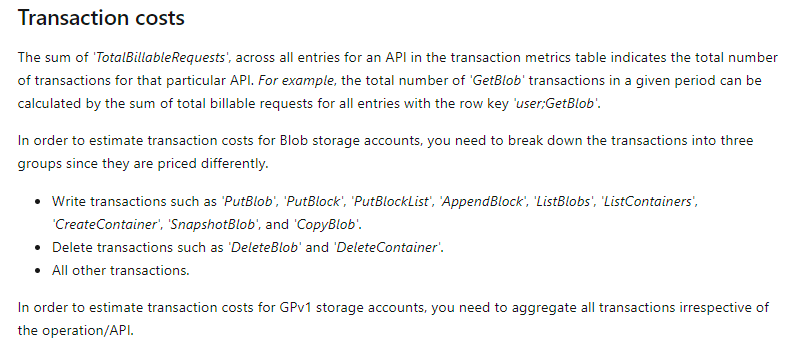@Carolina Zamisnicu Welcome to Microsoft Q&A Forum, Thank you for posting your query here!
Adding more information to the above response! GPV1 is the best option for your scenario. However I recommended to use GPV2 based on the features, options, availability in GPV2
If you still find any difficulties, I would recommended to contact Billing and Subscription team would be the best to provide more insight and guidance on this scenario:
https://azure.microsoft.com/en-us/support/options/ it's free, and it's the best choice for you.
Let me explain how transaction is billed This is bit old article but explains how transaction is charged with detailed information Understanding Windows Azure Storage Billing – Transactions
Storage account billing
Azure Storage bills based on your storage account usage. All objects in a storage account are billed together as a group. Storage costs are calculated according to the following factors:
- Region refers to the geographical region in which your account is based.
- Account type refers to the type of storage account you're using.
- Access tier refers to the data usage pattern you've specified for your general-purpose v2 or Blob storage account.
- Capacity refers to how much of your storage account allotment you're using to store data.
- Redundancy determines how many copies of your data are maintained at one time, and in what locations.
- Transactions refer to all read and write operations to Azure Storage.
- Data egress refers to any data transferred out of an Azure region. When the data in your storage account is accessed by an application that isn't running in the same region, you're charged for data egress. For information about using resource groups to group your data and services in the same region to limit egress charges, see What is an Azure resource group?.
The Azure Storage pricing page provides detailed pricing information based on account type, storage capacity, replication, and transactions. The Data Transfers pricing details provides detailed pricing information for data egress. You can use the Azure Storage pricing calculator to help estimate your costs.
To learn more, see the QuickStart on analyzing your costs.
Your Blob storage consumption, in gigabytes, including: How much data is being stored in the storage account? How does the data volume change on a monthly basis; does new data constantly replace old data?
The primary access pattern for your Blob storage data, including: How much data is being read from and written to the storage account?
How many read operations versus write operations occur on the data in the storage account? To decide on the best access tier for your needs, it can be helpful to determine your blob data capacity, and how that data is being used. This can be best done by looking at the monitoring metrics for your account.

Please let us know if you have any further queries. I’m happy to assist you further.
----------
Please do not forget to  and
and  wherever the information provided helps you, this can be beneficial to other community members.
wherever the information provided helps you, this can be beneficial to other community members.



 and
and  wherever the information provided helps you, this can be beneficial to other community members.
wherever the information provided helps you, this can be beneficial to other community members.